Categoria: Tips
Italy, Travel
Sobrevivendo à Farmácia Italiana: Guia para Viajantes para se Sentir Melhor no Exterior
Já ficou doente viajando? Aqui vai como navegar pelas farmácias italianas como um/uma expert.
Todo mundo já passou por isso: você acorda em um país estrangeiro com a garganta arranhando, uma dor de cabeça latejante ou um estômago arrependido da quarta porção de carbonara da noite anterior. De repente, suas férias ensolaradas em Roma viram uma caça a remédios — e você percebe rápido que não existe Walgreens, nem Boots e muito menos um Walmart 24 horas por perto.
Mas calma! As farmácias italianas são fáceis de encontrar e, com este guia, você saberá exatamente o que dizer, para onde ir e o que pedir quando não estiver se sentindo bem na Itália.
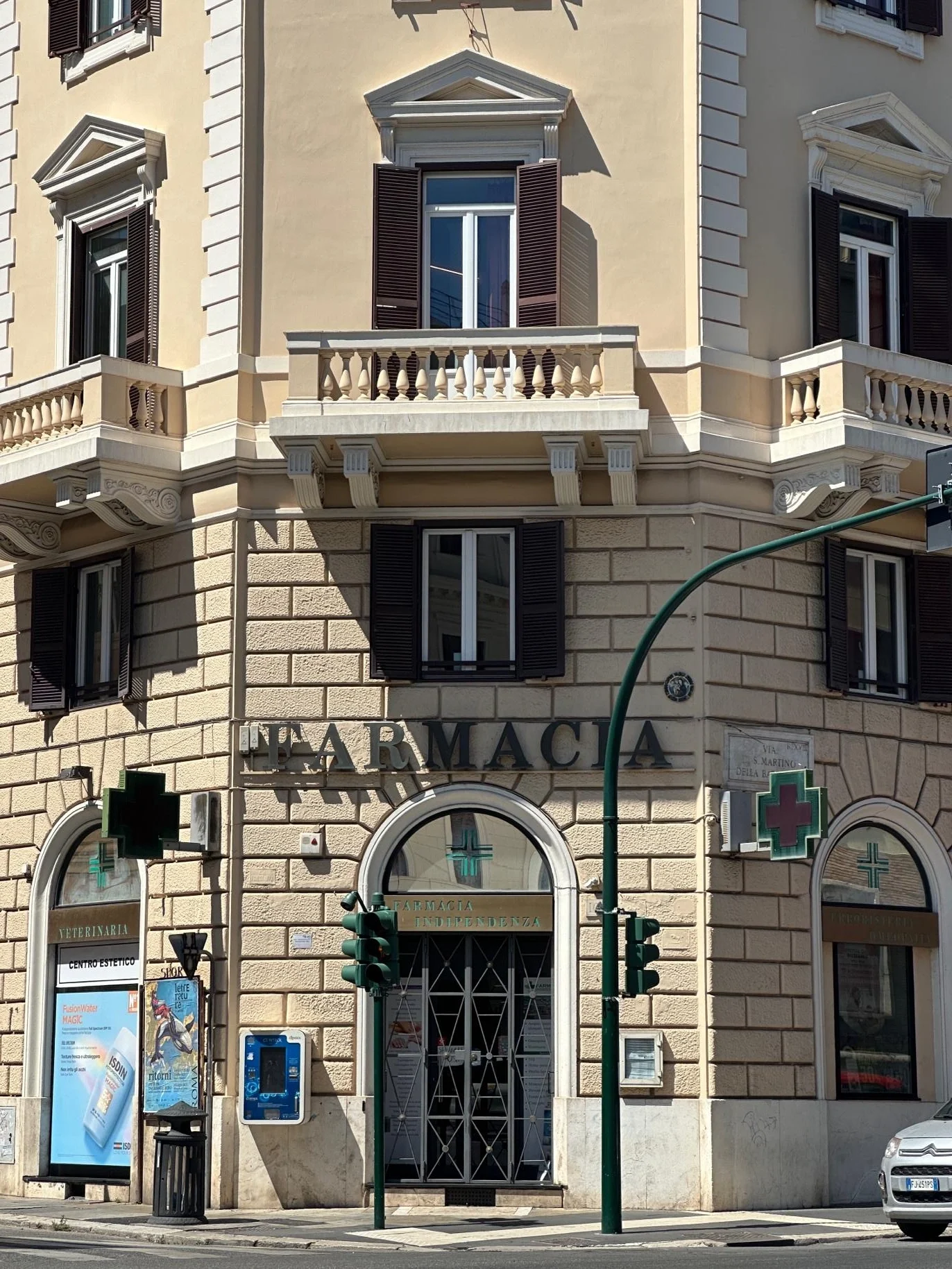
Como identificar uma farmácia na Itália
Procure a cruz verde iluminada — é o símbolo universal das farmácias na Itália. A maioria das farmácias (chamadas de “farmacia” em italiano) é independente, e você geralmente encontra mais de uma em cada bairro.
Em Roma, por exemplo, há mais de 10 farmácias a menos de 10 minutos a pé do YellowSquare, então você nunca estará longe de ajuda.
Os horários típicos são de 8h30 às 13h e de 15h30 às 19h30, de segunda a sábado, com horário reduzido aos domingos. Se você precisar de algo fora desses horários, sem stress — dá para verificar quais farmácias estão abertas à noite ou em feriados no site Farmacie di Turno Roma. É uma mão na roda para achar farmácias de plantão na sua área, especialmente aos domingos e no período da noite.
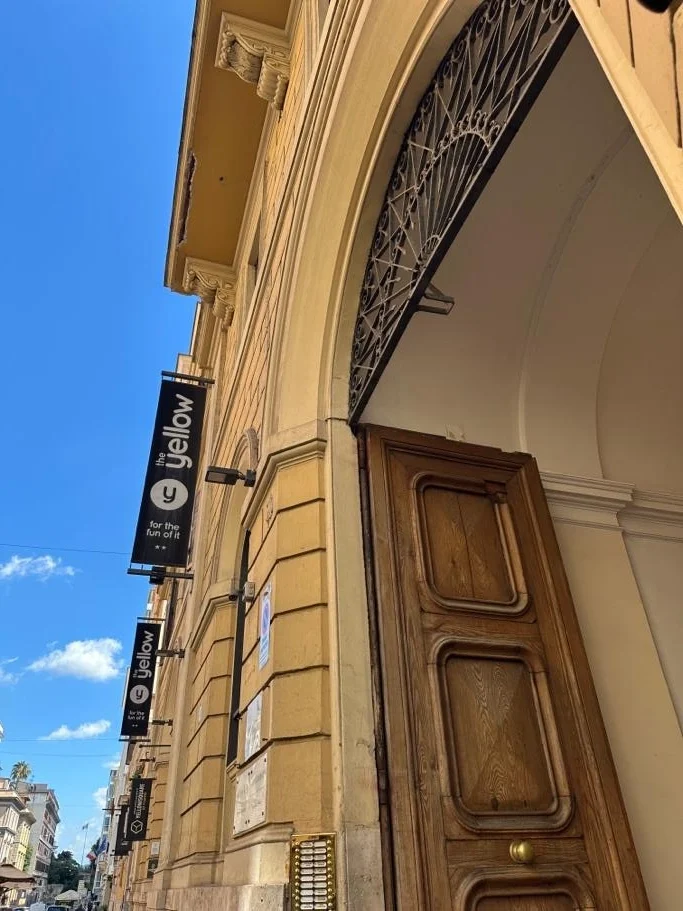

Curiosidades culturais:
As farmácias funcionam diferente por aqui
Na Itália, farmácia não é mini-mercado como em muitos países de língua inglesa. Embora você encontre itens de cuidado pessoal (shampoo, skincare, cosméticos), chás/fitoterápicos e produtos para bebês, não vai ver prateleiras de snacks, bebidas geladas ou mantimentos ao lado da aspirina. Aqui o foco é saúde e bem-estar, e vários medicamentos que seriam “de balcão” em outros lugares podem exigir a avaliação do farmacêutico.
Os/As farmacêuticos/as italianos/as funcionam como conselheiros/as de saúde da comunidade — você descreve os sintomas e eles sugerem o tratamento adequado. Isso ajuda muito quem está viajando: mesmo sem saber o nome do remédio, basta explicar como você está se sentindo que eles encontram uma solução.
Doenças/sintomas comuns e seus nomes em italiano
Para facilitar, um “cola” rápido com os termos básicos:
- Gripe = febbre
- Resfriado = raffreddore
- Alergias = allergie
- Tosse = tosse
- Nariz entupido = naso chiuso
- Nariz escorrendo = naso che cola
- Dor de garganta = mal di gola
- Dor de cabeça = mal di testa
- Enxaqueca = emicrania
- Estômago embrulhado = mal di stomaco
- Intoxicação alimentar = intossicazione alimentare
- Picadas de inseto = punture di insetti
O que dizer na farmácia
Quer chegar preparado/a? Use esta frase simples:
“Buongiorno! Ho un [sintomo] e cerco una medicina, per favore.”
(Bom dia! Estou com [sintoma] e procuro um remédio, por favor.)
Exemplo: “Buongiorno! Ho un raffreddore e cerco una medicina, per favore.”
Remédios mais populares sem receita
Alguns nomes que você vai ouvir bastante:
- Tachipirina: à base de paracetamol, para febre e dores leves.
- Oki: anti-inflamatório para dor de garganta, dor de cabeça ou dores articulares.
- Moment: ibuprofeno para dores de cabeça, cólicas ou febre.
- Enterogermina: probiótico para desconfortos intestinais ou após intoxicação alimentar.
- Imodium: mesma marca de outros países, para diarreia.
- Vicks Tosse: xarope para tosse.
- Zerinol: comprimidos para resfriado e gripe.
Observação: antibióticos sempre exigem receita médica na Itália.
Dicas sobre a “cultura da farmácia”: o que mais saber
Alguns detalhes que podem surpreender viajantes:
- A maioria dos remédios de balcão fica atrás do balcão. Raramente você verá as caixas em prateleiras abertas. Descreva os sintomas e o/a farmacêutico/a vai pegar o que você precisa.
- Farmacêuticos/as são profissionais de saúde altamente capacitados/as. Pense neles/as como consultores/as clínicos/as, não como vendedores/as. Não hesite em pedir orientação ou recomendações.
Nota: para medicamentos controlados ou com receita, podem solicitar um documento de identificação ou uma prescrição local; para compras comuns isso normalmente não é necessário.
O que NÃO fazer
- Não tome medicamentos sem saber exatamente o que são e para que servem. Mesmo que outra pessoa recomende, confirme com o/a farmacêutico/a — alguns remédios disponíveis em outros países podem não ser indicados para os seus sintomas.
- Sempre confira os ingredientes de um medicamento desconhecido. Pode ter o mesmo princípio ativo com outro nome, ou ser diferente e usado para o mesmo fim. Pergunte ao/à farmacêutico/a se tiver dúvidas.
- Considere procurar um médico se os sintomas durarem mais de alguns dias ou piorarem. Dá para marcar consulta com profissionais que falam inglês em serviços como Doctors in Italy.
Considerações finais
Ficar doente no exterior é chato, mas não precisa estragar a viagem. Com este guia, você encara o sistema das farmácias italianas com confiança — seja para curar a dorzinha de cabeça do dia seguinte ou algo mais sério. Viaje com cuidado, cuide de você e não esqueça um kit básico de primeiros socorros na mala.
Links
- Lista de Farmácias de Plantão em Roma: https://www.farmaciediturno.org/comune.asp?cod=58091
- Farmácias perto do YellowSquare Roma: https://maps.app.goo.gl/JYaHNTBKgx2EZLUB7
- Farmácia mais próxima do YellowSquare: https://maps.app.goo.gl/8hDhFKSAssMnBjU98
- Serviço para encontrar médicos que falam inglês: https://www.doctorsinitaly.com/
Leia mais
Rome, Travel
Tour Yourself on, Rome
(Uma viagem entre peregrinos, poetas e sonhadores, seguindo o fio dourado do Tridente)
Roma: o prazer de se perder… e o dom de se reencontrar
Quão maravilhoso é se perder nas ruelas de Roma?
É realmente uma caminhada repleta do prazer da descoberta: é inegável o magnetismo das maravilhas inesperadas que encontramos pelo caminho.
No entanto, depois de anos vivendo aqui, devo admitir que é ainda mais bonito “não se perder”, mas sim saber se reencontrar, usando como guia a conexão secreta entre praças, igrejas e monumentos.
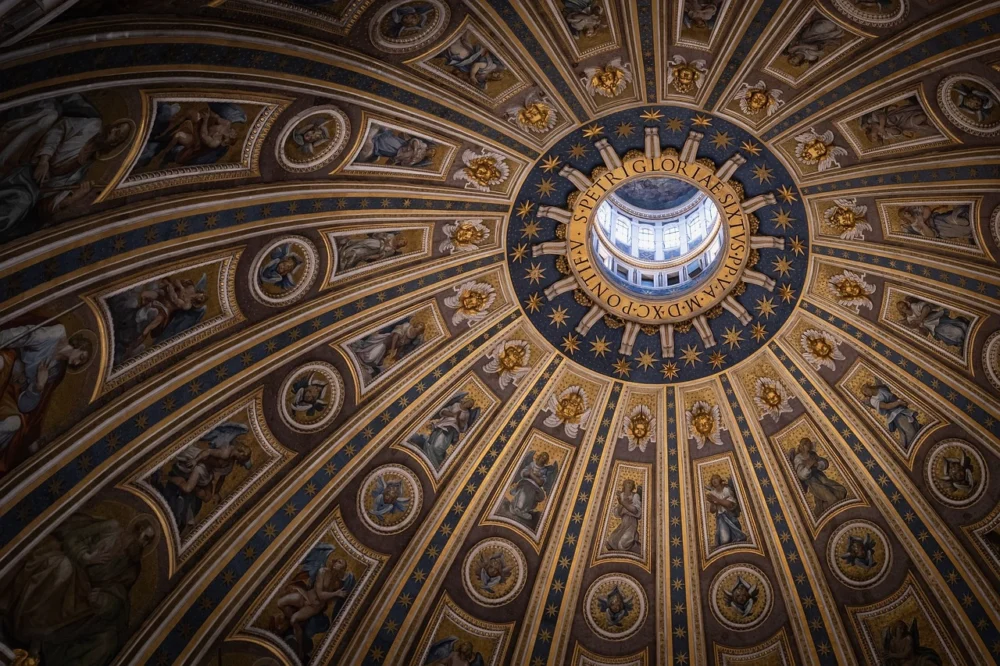
Um pequeno mergulho na história: o Concílio de Trento e a transformação de Roma
À medida que nos movemos de igreja em igreja como peregrinos modernos, vale a pena lembrar que essa forma de viver a cidade tem raízes profundas na história.
Após o Concílio de Trento (1545–1563), no auge da Contra-Reforma, a Igreja Católica decidiu renovar não apenas a sua doutrina, mas também a própria aparência das cidades.
Em Roma, isso significou um vasto programa de construção e renovação de igrejas, pensadas como instrumentos visíveis de fé e poder.
E não só isso: para guiar os fiéis até esses novos templos da espiritualidade, ruas foram endireitadas e novas vias criadas, muitas vezes alinhando os eixos viários diretamente com os locais de culto.
Graças a este impulso, nasceram obras monumentais como o Tridente — o cruzamento perfeito entre fé, urbanismo e beleza — e muitas das praças que exploramos hoje.
Assim, enquanto caminhamos, seguimos inconscientemente o projeto de uma época que queria guiar as almas… com ruas retas apontadas para o céu.
Assim como faziam os peregrinos de antigamente: caminhando de igreja em igreja, com a maravilha nos olhos, como os primeiros “turistas” da história.
Então, vamos começar também pela “porta das portas de Roma”: Porta Flaminia, hoje mais conhecida como Porta del Popolo.
Ao atravessá-la, surge diante de nós a Piazza del Popolo, com seu icônico Tridente: três ruas que se ramificam como os dentes de um tridente, em um grande projeto urbanístico realizado no século XVI.
Antes de partir, porém, vale a pena explorar bem a praça: ela está cheia de surpresas.
Desde as paredes que transportam a voz como um eco misterioso, às obras-primas de Caravaggio na Igreja de Santa Maria del Popolo, até o pequeno, mas curioso Museu Leonardo da Vinci Experience.
E, naturalmente, não esqueça que esta praça ainda hoje é palco de encontros populares: eventos, manifestações e protestos oferecem uma experiência viva e autêntica da cidade.
Agora, vamos falar do Tridente.
Para nos guiar, usaremos uma metáfora culinária: cada rua será como uma refeição do dia — café da manhã, almoço e aperitivo/jantar.
Pronto para viver Roma como verdadeiros peregrinos… e também um pouco como poetas e pintores românticos?
Babuino no Café da Manhã
Começamos nosso caminho entrando na Via del Babuino, perfeita para uma caminhada energética rumo ao bairro Monti.
Imagine-se no século XIX: um poeta romântico, um flâneur, deixando-se inspirar pelo ar antigo e novo de Roma.
Depois, volte ao presente e dê uma olhada nos preços das vitrines: você está no coração do bairro de luxo romano!
Pelo caminho, descobrimos uma joia: Canova Tadolini, um antigo ateliê de escultura fundado em 1818, hoje transformado em restaurante-museu.
Aqui, as mesas parecem coadjuvantes diante da majestade das esculturas ao redor. Um lugar mágico, onde se respira arte em cada canto.
Poucos passos adiante, chegamos à Piazza di Spagna, com a famosa Fonte da Barcaccia esculpida pelos Bernini, e a espetacular Escadaria da Trinità dei Monti.
Uma subida que é um verdadeiro banquete para os olhos, culminando na vista panorâmica dos terraços da Trinità.
Continuamos à direita pela Via Sistina, que nos leva à Piazza Barberini, dominada pela Fonte do Tritão de Bernini.
Pouco mais adiante, encontramos uma obra-prima escondida: As Quatro Fontes e a pequena e encantadora igreja de San Carlo de Borromini.
Se seguirmos em frente, chegamos à majestosa Basílica de Santa Maria Maggiore.
Bem em frente, você pode aproveitar um merecido café da manhã em um dos cafés da área: um cappuccino e um croissant irão restaurar suas forças.

Através de Monti em Direção ao Coliseu
Da Basílica de Santa Maria Maggiore, pegamos a Via Urbana para entrar no Rione Monti, um dos bairros mais fascinantes de Roma.
Passeie sem pressa até chegar à Piazza della Madonna dei Monti, e prepare-se: a poucos passos, o Coliseu surgirá diante de você, como um gigante antigo.
O percurso continua através dos Fóruns Imperiais, até chegar ao Altar da Pátria (Vittoriano).
De lá, olhando para trás, você verá a Piazza del Popolo. Como um fio invisível, as ruas do Tridente ainda nos conectam.
Um Almoço Rápido Perto do Corso?
Se a fome bater, é o momento perfeito para o almoço!
Você pode escolher ser tratado como realeza em um restaurante elegante ou viver uma experiência mais “raiz” em uma típica osteria romana.
Um exemplo perfeito: a histórica Birreria Peroni, onde ainda hoje se respira a atmosfera genuína de um almoço entre amigos.
Não se surpreenda se, depois da refeição, gentilmente pedirem para liberar a mesa: é parte do ritual romano do “come e passa”!

Aperitivo em Trastevere: Boêmio por uma Noite
Após o almoço, se você quiser mergulhar em uma das tradições mais celebradas da italianidade, o aperitivo é obrigatório.
E o bairro ideal para isso é Trastevere.
O caminho até lá é um sonho: Panteão, Piazza Navona, Palazzo Madama, até chegar à Basílica de Sant’Agostino, onde você poderá admirar a célebre Madonna dos Peregrinos de Caravaggio.
Aliás, essa igreja está alinhada visualmente com a Piazza del Popolo, mais uma prova de que o Tridente nos guia.
Atravesse então a Ilha Tiberina, considerada um dos primeiros assentamentos da Roma Antiga.
Dali, um último trecho de caminhada leva você finalmente a Trastevere, onde recomendo reservar uma trattoria para saborear um maravilhoso cacio e pepe ou uma suculenta amatriciana.
Enquanto espera o jantar, com um spritz na mão — sim, na Itália é permitido beber na rua até as 22h! — aproveite um passeio sem rumo pelas ruelas iluminadas.
Na Piazza Trilussa, você sempre encontrará artistas de rua, músicos e mímicos.
Feche os olhos por um instante: ouça os sons, observe as cores, respire o ambiente.
Você entenderá que, apesar dos séculos, nada mudou: Roma continua sendo esse eterno cruzamento de povos, línguas, sonhos e poesia.
Leia mais
Milan
O que fazer em Milão em 1 dia: melhores atrações, comidas e experiências em 24 horas
Como chegar ao YellowSquare Milan desde o aeroporto
- Do Aeroporto de Malpensa (MXP)
- Trem Malpensa Express até Milano Centrale (€13, 50 min)
- Metrô Linha 3 (amarela) até Lodi TIBB (4 paradas, €2.20)
- 5 minutos de caminhada até o YellowSquare Milan
- Do Aeroporto de Linate (LIN)
- Ônibus 73 até San Babila M1 (€2.20, 25 min)
- Metrô Linha 1 (vermelha) até Duomo, depois Linha 3 (amarela) até Lodi TIBB
- Do Aeroporto de Bérgamo Orio al Serio (BGY)
- Ônibus shuttle até Milano Centrale (€10, 50 min)
- Metrô Linha 3 (amarela) até Lodi TIBB
Para horários e atualizações, consulte Trenord e ATM Milano.
Manhã: Duomo de Milão & Galleria Vittorio Emanuele II
- Visite o Duomo de Milão
– Suba até os terraços para uma vista panorâmica (€15–20 com elevador)
– Metrô Linha 3 (amarela) de Lodi TIBB até Duomo (5 paradas, €2.20)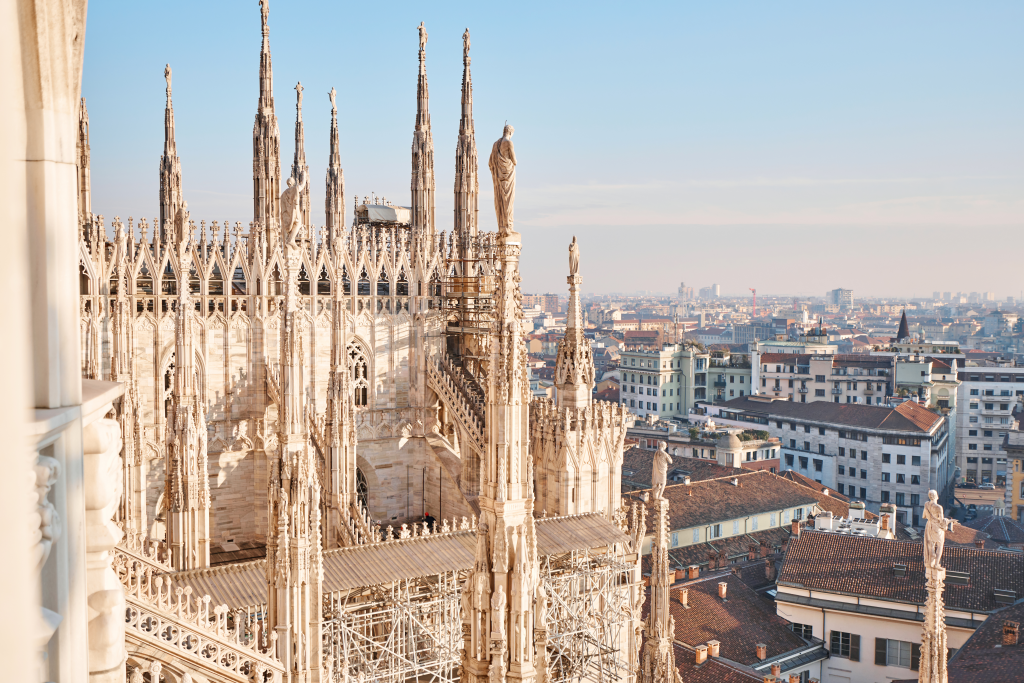
- Explore a Galleria Vittorio Emanuele II
– Entrada gratuita, ótima para fotos e para dar uma voltinha sobre o mosaico do touro da sorte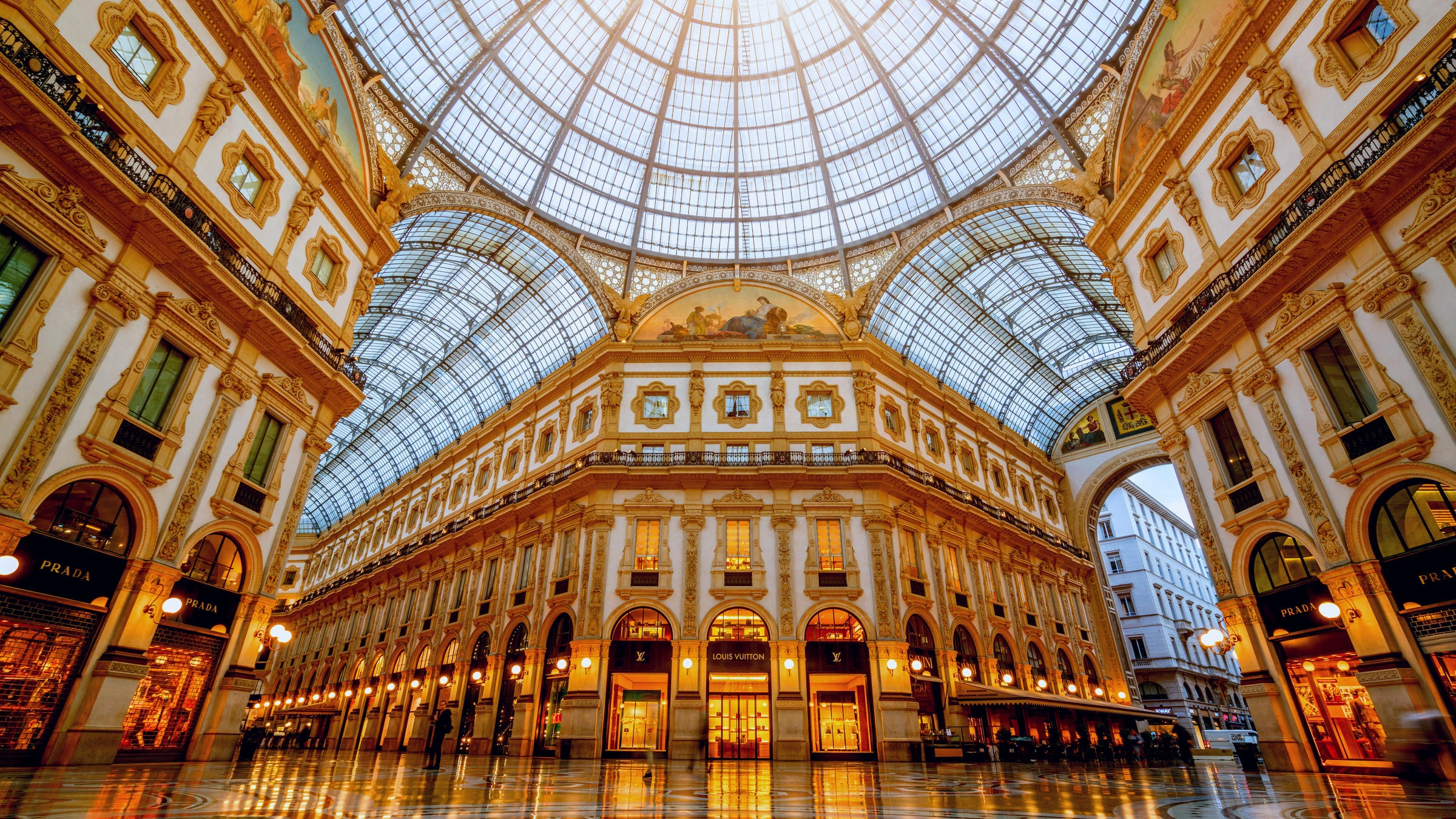
🎟️ Compre seu ingresso para o Duomo aqui
Meio-dia: Almoço nos canais de Navigli + caminhada
- Próxima parada no seu roteiro de 24h por Milão: o bairro dos Navigli, conhecido por seus canais, pontes e vida urbana vibrante.
– Do Duomo: Metrô Linha 3 até Porta Romana, depois Tram 9 até Porta Genova
– Faça uma caminhada pelas margens, confira lojas pequenas, galerias e artistas de rua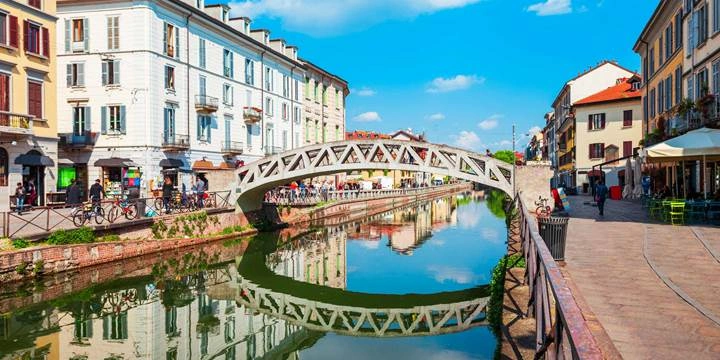
Onde comer: Le Striatelle di Nonna Mafalda (Dica Local)
- 📍 Via Vigevano, 11 – Bairro Navigli
- O que pedir:
- Cotoletta di Maiale (filé de porco empanado)
- Risoto alla Milanese
- Peça o vinho da casa — bom e barato!
- Preço: Cerca de €15–20 por pessoa
Este é seu YellowSquare Italian Super Tip™ — um lugar local autêntico que vale a visita!
Tarde: Castello Sforzesco e Parco Sempione
- 🏰 Visite o pátio do castelo (gratuito) ou os museus (€5)
- 🌳 Relaxe no Parco Sempione com um gelato
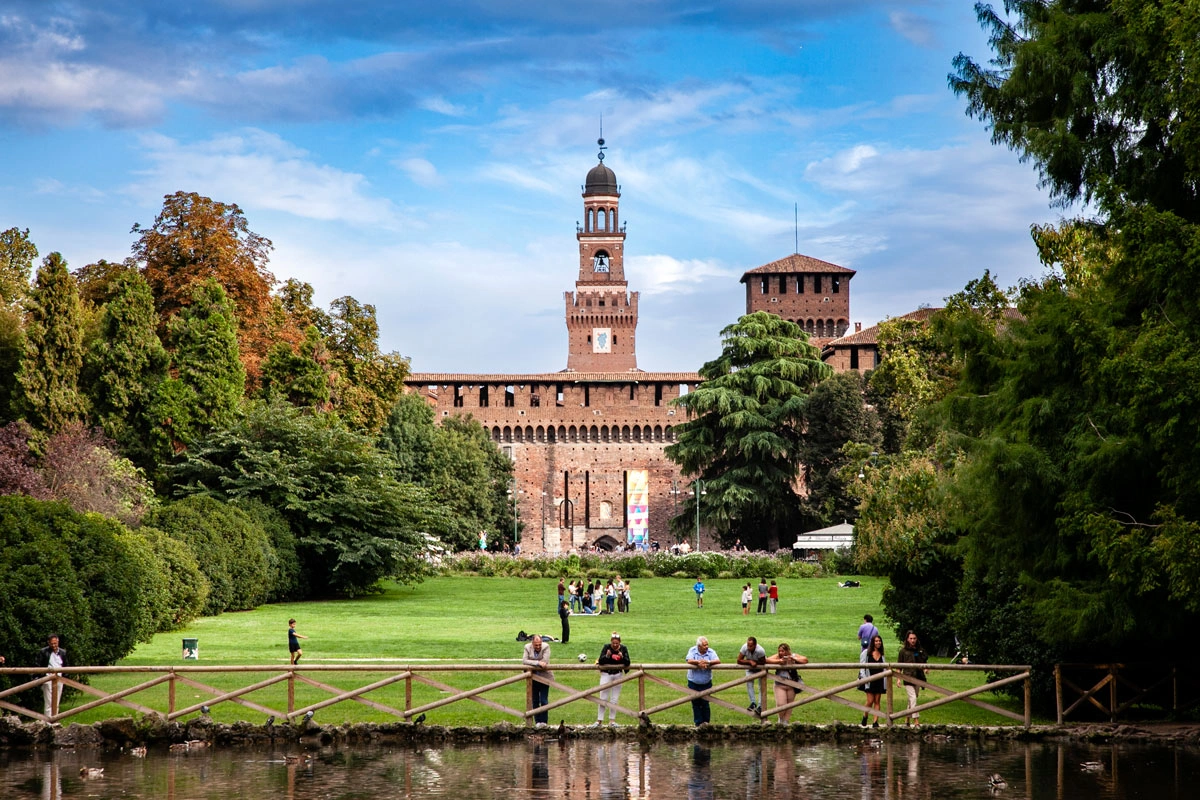
🎟️ Planeje sua visita ao Castello Sforzesco
Noite: Hora do Aperitivo – Duas ótimas opções
- Finalize seu dia em Milão com a tradição local: o aperitivo.
Opção 1: Aperitivo no YellowSquare Milan
- 📍 YellowSquare Milan, Via Serviliano Lattuada, 14
- Desconto no aperitivo das 20h às 21h todos os dias! Ambiente descontraído e internacional
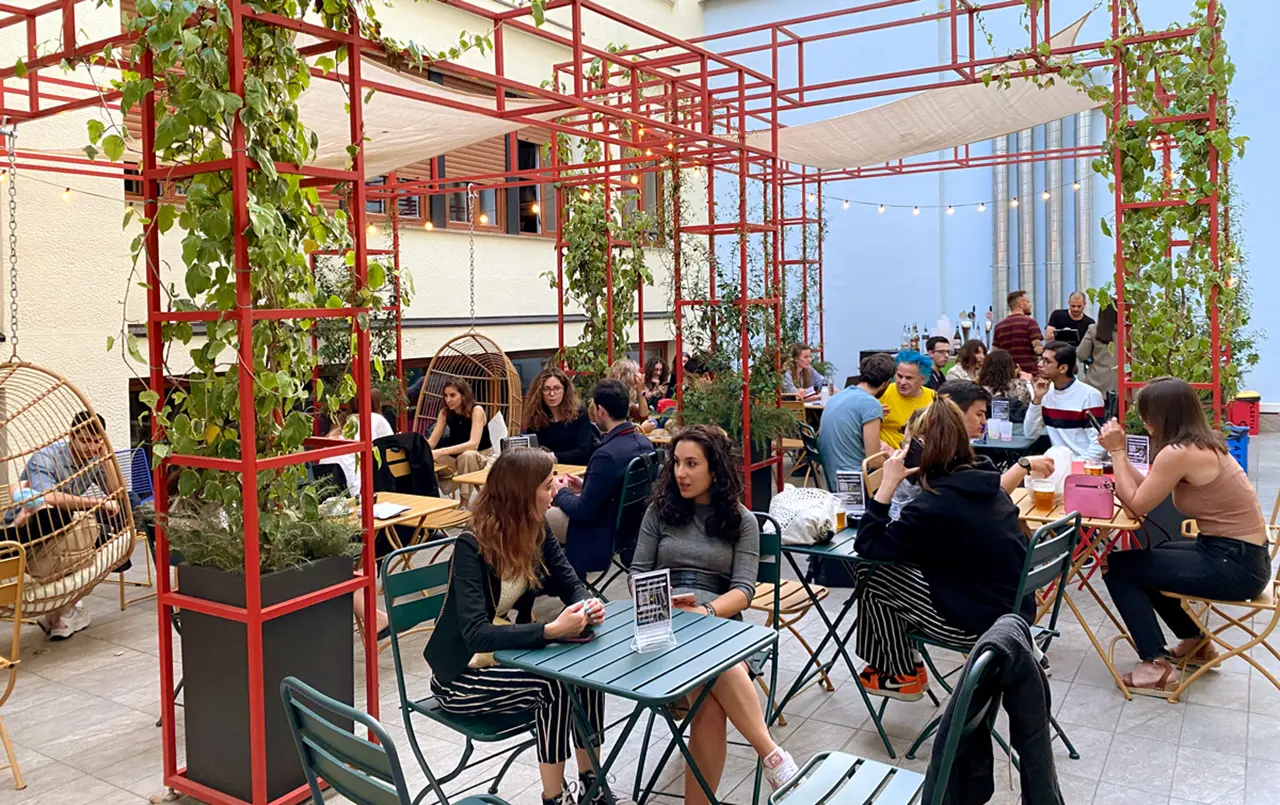
Opção 2: Aperitivo na Casa Tua Osteria
- 📍 Via Lodovico Muratori, 10 – 10 minutos a pé do YellowSquare
- Ambiente aconchegante e acessível
- Drinks + petiscos a partir de €7–9
Veja no Google Maps
Joia escondida: Fondazione Prada
- 📍 A 15 min a pé do YellowSquare ou ônibus 65 até P.ta Lodovica
- Arte e design contemporâneo em uma antiga destilaria
- Não perca o Bar Luce, projetado por Wes Anderson
- Entrada a partir de €15, áreas externas gratuitas
Explore a Fondazione Prada
Dicas práticas para seu dia em Milão
- Compre o passe diário (€7.60) para metrô e ônibus ilimitados
- Use os lockers do YellowSquare se for fazer check-out cedo
- Mantenha-se hidratado e tome um bom café para manter a energia
Milão pode te surpreender mesmo em apenas um dia. Com este roteiro de 1 dia em Milão, você vai visitar os destaques, provar sabores locais e ainda curtir o clima único da cidade. Volte quando quiser ou confira mais dicas no nosso YellowSquare blog.
Aproveite o dia 🙂
Leia mais
Italy, Rome
Nemi, o passeio perfeito para os amantes de moranguinhos
Com a chegada de abril, podemos finalmente dizer que a primavera chegou — e com ela, a temporada de morangos.
Para mim, isso só pode significar uma coisa: Nemi.
Para quem está viajando pela Itália e quer realmente mergulhar na sua essência, é fundamental visitar o maior número possível de vilarejos italianos. Essas pequenas cidades encantadoras mostram exatamente o que tornou a Itália famosa no mundo todo: a tradição.
Eleito um dos vilarejos mais bonitos da Itália em 2023, Nemi é um destino imperdível — especialmente para os amantes de morangos.
Como chegar a Nemi?
Se você estiver hospedado no YellowSquare, pode chegar a Nemi de carro em cerca de cinquenta minutos. Outra opção é pegar o trem a partir da estação Termini de Roma, e descer em Albano Laziale ou Velletri. De lá, você encontrará ônibus que vão direto para Nemi.

Por que Nemi?
A essa altura, você deve estar se perguntando: o que os morangos têm a ver com esse guia? Pois bem, Nemi é conhecida não só pelas flores, mas principalmente por seus moranguinhos, que começam a aparecer no início de abril.
Pequenos, perfumados e incrivelmente doces, eles são cultivados há gerações nos arredores do lago, graças a um microclima único. Por isso, de abril a julho, você verá morangos em praticamente todos os pratos: tortas, bolos, geleias, sorvetes…
O ponto alto da temporada é a Festa do Morango, tradição que começou no início dos anos 1900 e que ainda acontece todos os anos, no primeiro domingo de junho. Nessa data, o vilarejo se enche de barracas, doces, licores e alegria. As “fragolare” — mulheres com roupas típicas — percorrem as ruas distribuindo cestas de frutas frescas, enquanto apresentações folclóricas e música ao vivo tomam conta do lugar.
Se quiser se deliciar em grande estilo, recomendo ir no domingo, 1º de junho, e aproveitar tudo isso de perto!
Mesmo antes da festa, a primavera em Nemi já oferece delícias para todos os gostos. De tudo o que experimentei, recomendo muito o bistrô dentro do parque público (que você visitará com minha dica): eles servem massas doces recheadas com creme e morangos frescos, acompanhadas de sorvete e uma vista maravilhosa. Um lugar perfeito para relaxar, curtir a paisagem ou jogar cartas com os amigos.

O que ver em Nemi?
Começando pelo charmoso centro medieval, Nemi tem ruelas pitorescas, lojinhas artesanais e produtos locais que vão além dos morangos. Mas, além do tour gastronômico, o vilarejo oferece paisagens incríveis e contato direto com a natureza.
Logo você vai notar a vista para o Lago de Nemi — que pode ser acessado a pé, se estiver com calçado apropriado. Existem várias trilhas ao redor do lago com diferentes níveis de dificuldade.
Entre os melhores pontos panorâmicos está o Belvedere degli Innamorati, que faz referência às lendas mitológicas gregas da região. Depois do mirante, siga pelo caminho panorâmico nos jardins públicos, com vista para as colinas que cercam o lago.
Uma dica pouco conhecida: visite o jardim do Santuário do Santíssimo Crucifixo. Lá você verá um visual lindo emoldurado por flores coloridas e sebes estilo francês. Do lado, uma varandinha panorâmica tranquila — ótima para quem quer um momento de paz em meio à natureza.

Resumindo: contei todos os detalhes do passeio que fiz com meus amigos no verão passado. E posso dizer: Nemi nos conquistou com seus morangos e vistas inesquecíveis!
Mas Nemi é só uma das muitas joias dos Castelli Romani. Com tanta beleza na região, vale muito a pena visitar outros vilarejos também — ou até planejar um fim de semana prolongado para explorar todos com calma. Uma oportunidade perfeita para curtir uma vida mais tranquila, longe do agito da cidade.
E você, já foi a Nemi?
Se tiver dúvidas, curiosidades ou quiser trocar uma ideia, me encontra no Yellow Bar!
Carolina
Leia mais
Rome
Caravaggio de graça em Roma: roteiro a pé
Já moro em Roma há um tempo, e essa cidade nunca deixa de me surpreender!
Às vezes eu e meu namorado voltamos a lugares já conhecidos só para relembrar histórias antigas. Roma tem sempre algo novo e curioso para ensinar.
Dessa vez, foi sobre Caravaggio. Me lembrei de um tour que fiz quando estava aprendendo italiano, lá em 2018.
Em 2024, meu namorado virou e perguntou:
“Você sabia que tem várias obras do Caravaggio espalhadas por Roma que dá pra ver de graça?”
Respondi: “SIM! Não lembro o caminho certinho, mas vamos tentar lembrar juntos!”
Como eu não lembrava o trajeto todo, depois que refizemos juntos o passeio, resolvi escrever umas dicas rápidas de caminhada para mim e para os amigos. Acabou virando esse artigo para o YellowSquare, já que costumo usar o hostel como ponto de partida. Assim não esqueço da próxima vez 😄
Descubra Caravaggio de graça em Roma – um passeio a pé
Quem foi Caravaggio?
Michelangelo Merisi da Caravaggio foi um pintor revolucionário do período barroco, conhecido pelo uso dramático de luz e sombra.
E o melhor: dá pra ver várias das suas obras-primas em Roma, sem pagar nada!
Siga esse tour autoguiado a pé e conheça as igrejas que guardam os quadros dele no centro histórico.
Ponto de partida
Eu comecei o passeio saindo do YellowSquare Rome — é central, perto da Estação Termini, onde deixo o carro e tomo um café.
Você também pode parar no Yellow Bar antes de começar. A primeira parada é a igreja em Piazza Navona.
Eu gosto de caminhar, mas você pode conferir as linhas de ônibus ou metrô mais próximas.
1. San Luigi dei Francesi
Endereço: Piazza di San Luigi de’ Francesi, 00186 Roma – Capela Contarelli
Horários: Todos os dias das 09:30 às 12:15 e das 14:30 às 18:30
A poucos passos da Piazza Navona fica a igreja nacional da França em Roma. Dentro da Capela Contarelli estão três obras icônicas de Caravaggio:
- A Vocação de São Mateus (1599–1600)
- A Inspiração de São Mateus (1602)
- O Martírio de São Mateus (1599–1600)
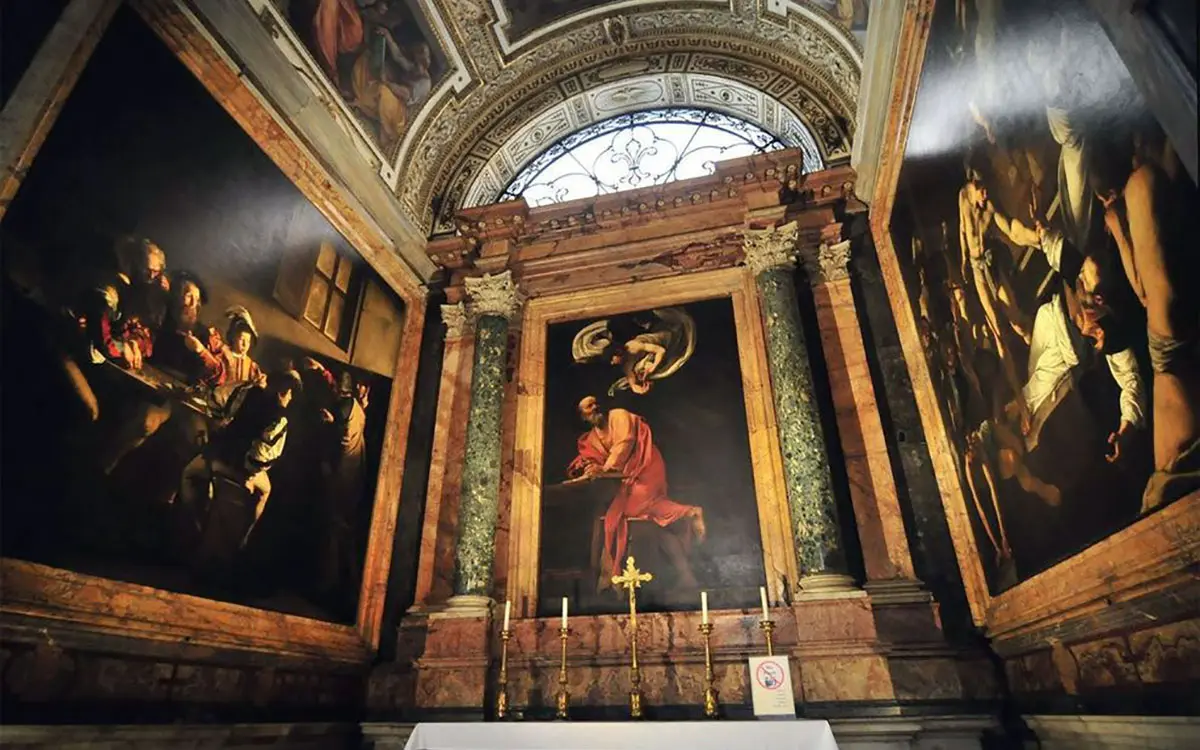
Essas pinturas mostram momentos-chave da vida de São Mateus com realismo intenso. A entrada é gratuita, mas você pode doar algumas moedas para acender as luzes e ver melhor os quadros.
2. Sant’Agostino
Endereço: Piazza di Sant’Agostino, 00186 Roma
Horários: Segunda a sábado das 09:00 às 11:30 e das 16:00 às 17:00 / Domingo: das 16:00 às 17:00
Nesta igreja está o quadro Madonna di Loreto (1604–1606), com uma representação muito humana da Virgem Maria, de pés descalços e rosto simples — o que causou escândalo na época.
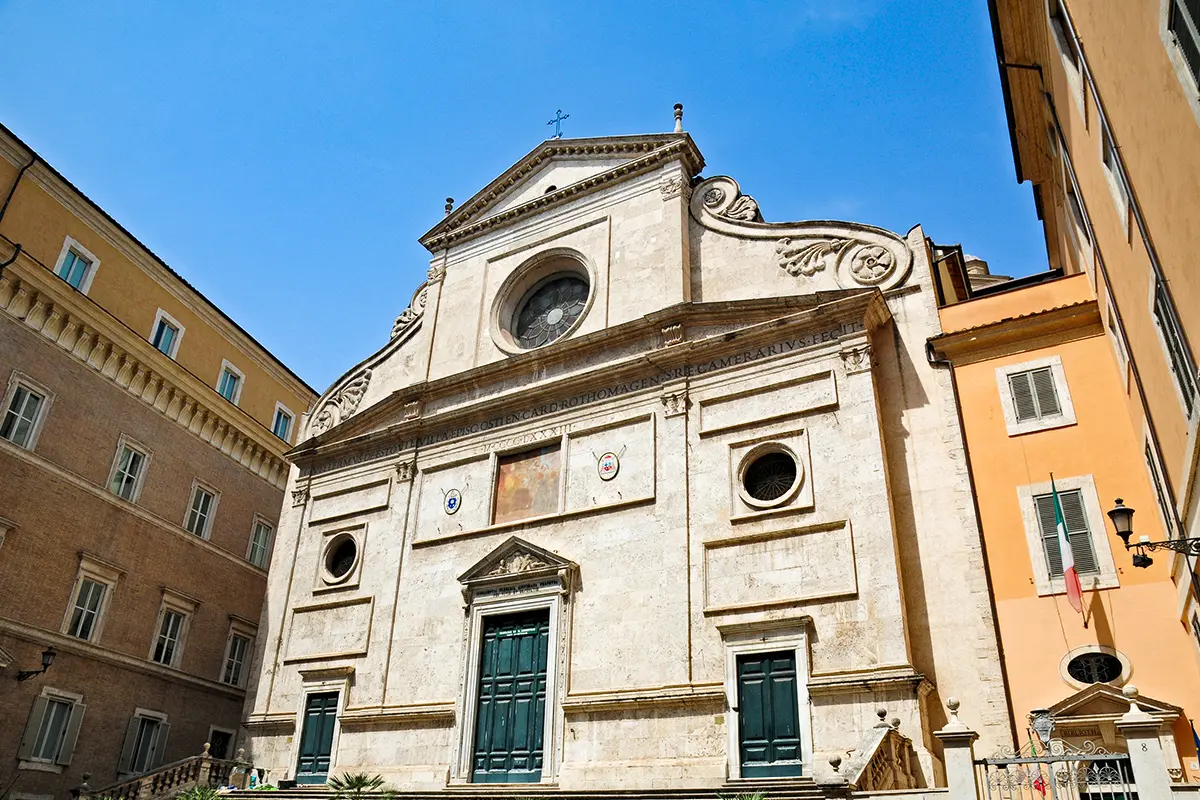
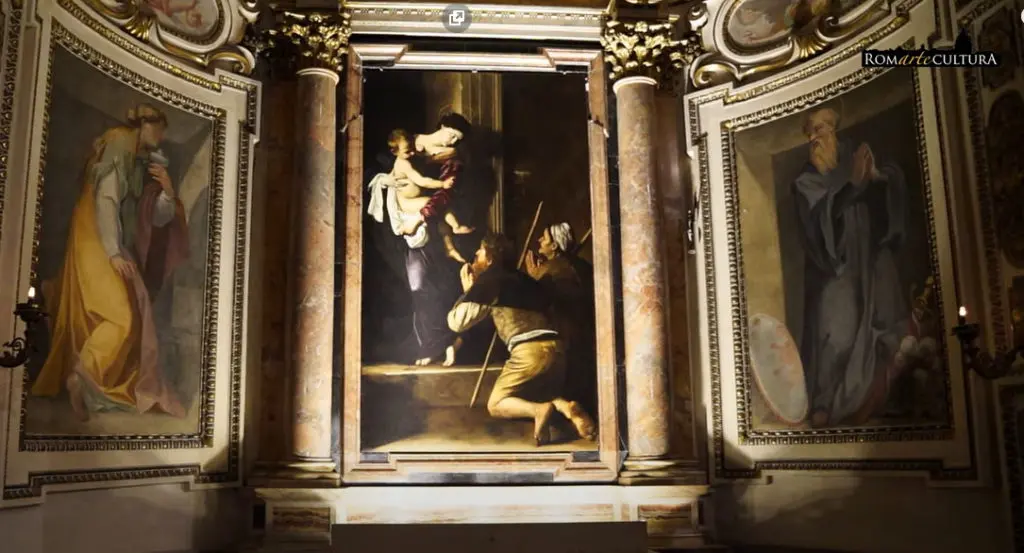
3. Curiosidades sobre Caravaggio
Onde ele morava: Vicolo del Divino Amore (perto da Piazza Navona)
Caravaggio morou em vários locais, incluindo essa ruazinha. Tem placas no caminho indicando onde era o apartamento dele. Se for à noite, uma luz automática ilumina o beco. Dizem que ele estudava a luz entrando pela janela para compor seus quadros.
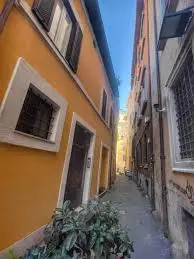
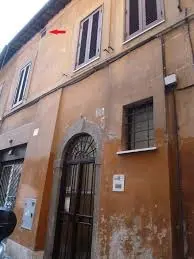
Onde ele bebia: Bar dell’Orso (perto do Campo de’ Fiori)
Caravaggio era conhecido por frequentar tavernas. Essa era um ponto de encontro de artistas, rebeldes e gente à margem da sociedade.
Onde ele cometeu um crime: Via della Pallacorda, 00186 Roma
Em 1606, Caravaggio matou Ranuccio Tomassoni durante uma briga. Fugiu de Roma logo depois e seguiu para Florença.
4. Basílica de Santa Maria del Popolo
Endereço: Piazza del Popolo, 12, 00187 Roma
Horários: Todos os dias das 07:30 às 19:00

Na Capela Cerasi estão dois quadros intensos de Caravaggio:
- A Conversão de São Paulo (1601)
- A Crucificação de São Pedro (1601)

Exemplo perfeito do chiaroscuro: o contraste dramático de luz e sombra.
Dica: visite durante o dia para aproveitar a luz natural.
Esse é meu passeio gratuito favorito por Roma!
Criei um mapa no Google Maps com todo o trajeto.

Quer ver mais Caravaggio?
Depois da caminhada gratuita, dá pra visitar museus incríveis com obras dele:
1. Galleria Borghese – Piazzale Scipione Borghese, 5
Obras: Garoto com Cesta de Frutas, Davi com Cabeça de Golias
Preço: €13–€17 – Reserva obrigatória
2. Palazzo Barberini – Via delle Quattro Fontane, 13
Obra: Judite e Holofernes
Preço: €12
3. Museus Capitolinos – Piazza del Campidoglio, 1
Obra: A Cigana
Preço: €15–€16
4. Galleria Doria Pamphilj – Via del Corso, 305
Obras: Fuga para o Egito, Madalena Arrependida
Preço: €14
Dicas para o passeio
- Melhor horário: manhã ou fim de tarde
- Entrada: igrejas grátis, museus pagos
- Levar: sapatos confortáveis, água e moedas para doação
- Transporte: Metrô linha A – estação Flaminio (Santa Maria del Popolo) ou Barberini (Palazzo Barberini)
Esse passeio é uma ótima forma de conhecer Roma com os olhos de Caravaggio – e sem gastar quase nada!
PS: o mapa que criei tem também uma camada extra com os museus pagos:
Passeio gratuito + Museus

Espero que esse roteiro te inspire a explorar Roma e mergulhar na arte e vida de Caravaggio!
Boa caminhada 🙂
Leia mais
Rome
Filmes icônicos filmados em Roma
A Cidade Eterna cativa contadores de histórias há milênios: desde os registros de Tito Lívio na Roma Antiga até o remake de 2024 de Gladiador com Paul Mescal, Roma permanece no centro das atenções. Seja pelo fascínio pelas lutas de gladiadores ou pela herança religiosa da cidade, Roma já se transformou várias vezes em um set de cinema ao ar livre para entreter o mundo inteiro. Na sua visita a Roma, reserve um tempo para conhecer os lugares onde essas cenas icônicas foram filmadas e viva a história do cinema de perto.
Filmes
1) A Doce Vida (La Dolce Vita), 1960
Gravado durante a “era de ouro” romana dos anos 50 e 60, esse clássico dirigido por Federico Fellini é lembrado principalmente pela cena romântica e provocante na Fontana di Trevi. Mesmo quem nunca viu o filme reconhece a imagem de Anita Ekberg entrando de vestido nas águas cristalinas ao lado do galã italiano Marcello Mastroianni. Sentiu vontade de repetir a cena? Melhor não: o mergulho custa uma multa de 450 euros. Mas admirar Oceanus, seus cavalos, o carro em forma de concha e os tritões, isso é totalmente gratuito. Dica: vá à 1h da manhã – iluminada e sem multidões.
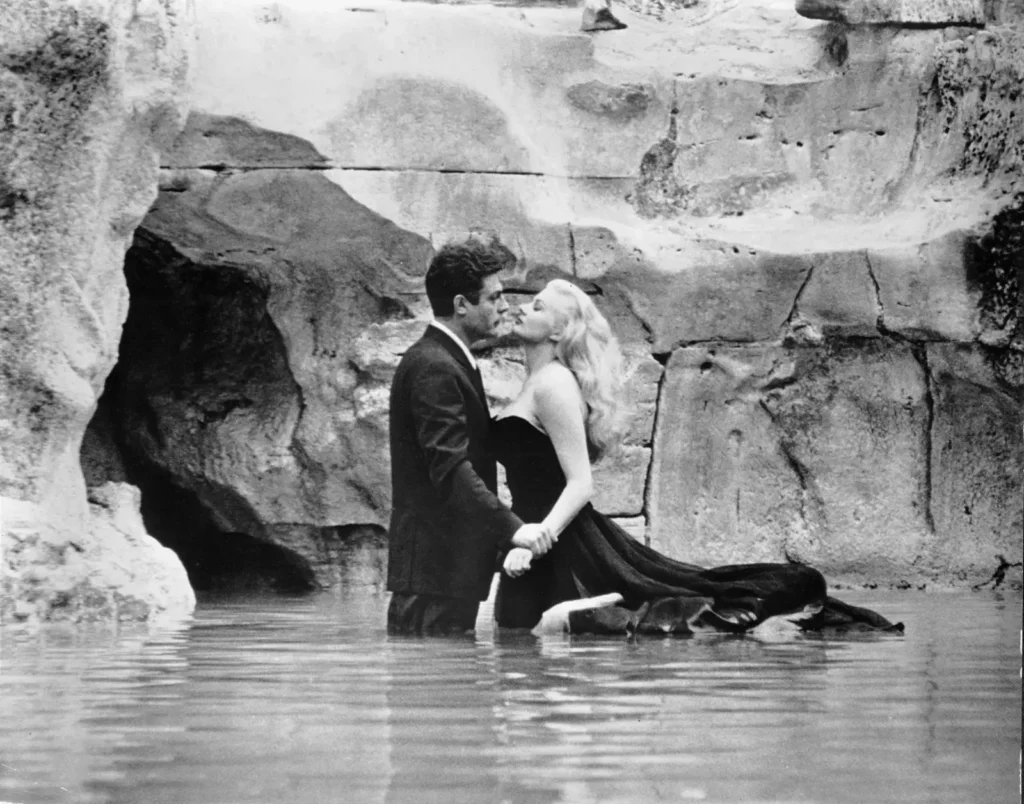
2) O Talentoso Ripley, 1999
Esse thriller psicológico estrelado por Matt Damon, Jude Law e Gwyneth Paltrow se passa entre Roma, Veneza e a Costa Amalfitana. Uma história cheia de reviravoltas, mentiras e mistérios, com cenas filmadas em lugares icônicos como a Piazza di Spagna — que leva esse nome graças ao Palazzo di Spagna, sede da Embaixada da Espanha junto ao Vaticano. Se ainda não viu, esse filme é obrigatório antes de visitar Roma. E claro, faça um dos tours do Yellow para conhecer esse e outros cenários clássicos da cidade!

3) Gladiador, 2000
Apesar de não ter sido filmado de fato no Coliseu, o filme recria com intensidade o espírito dos combates romanos. Na versão original, temos Russell Crowe e Joaquin Phoenix; no remake de 2024, Paul Mescal e Pedro Pascal, ambos dirigidos por Ridley Scott. A obra retrata o Coliseu e a vida dos gladiadores de forma emocionante. Dica: compre seu ingresso antecipadamente para evitar filas e aproveitar melhor a cidade.


4) Lizzie McGuire – Um Sonho Popstar, 2003
Um clássico para a Geração Z! Lizzie viaja a Roma com a escola, se apaixona por Paolo e vira uma popstar por acidente. Eles passeiam de Vespa vermelha por toda a cidade, passando pelo Pantheon e pela Piazza della Repubblica. Ficar em um hostel como o Yellow é o melhor jeito de conhecer pessoas novas em Roma — e quem sabe encontrar o seu próprio Paolo?
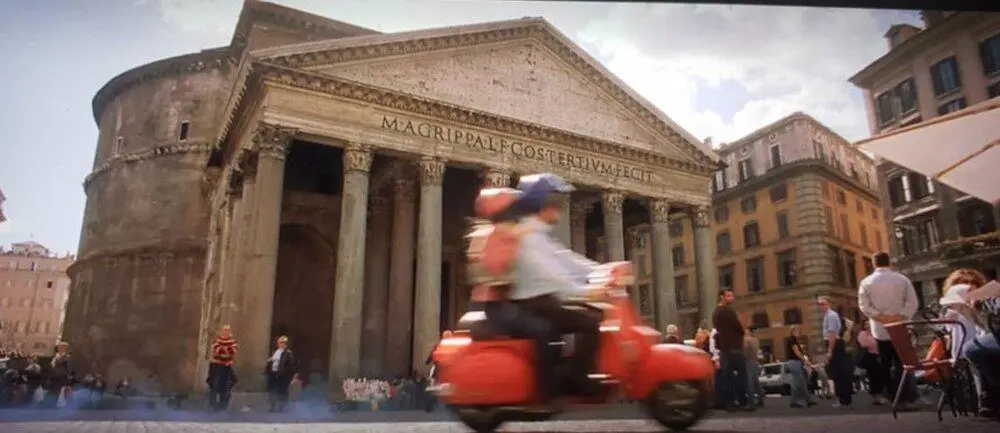
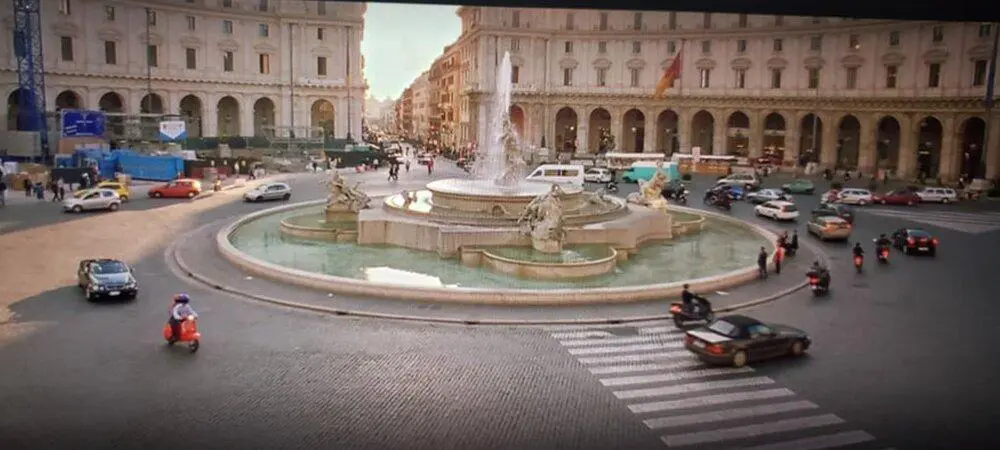
5) Comer, Rezar, Amar, 2010
Estrelado por Julia Roberts e baseado no livro de Elizabeth Gilbert, o filme acompanha sua jornada interior por Itália, Índia e Indonésia. Em Roma, o foco é “Comer”: gelato artesanal, pratos de espaguete em belas piazzas, água fresca gratuita das fontes chamadas nasoni como na Via dell’Orso… é impossível não se apaixonar.
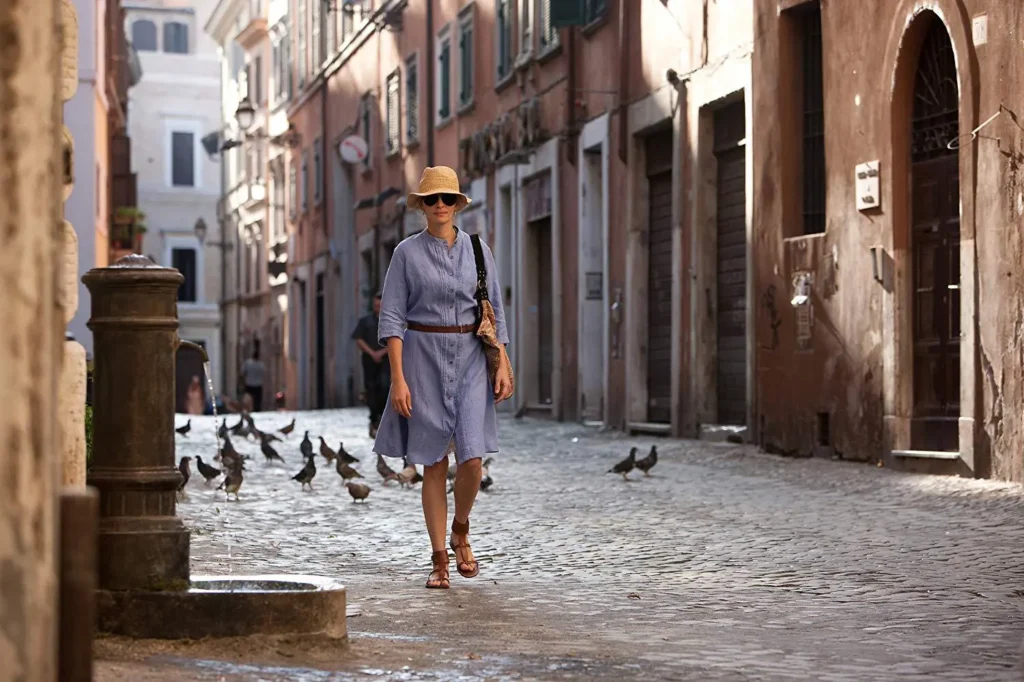
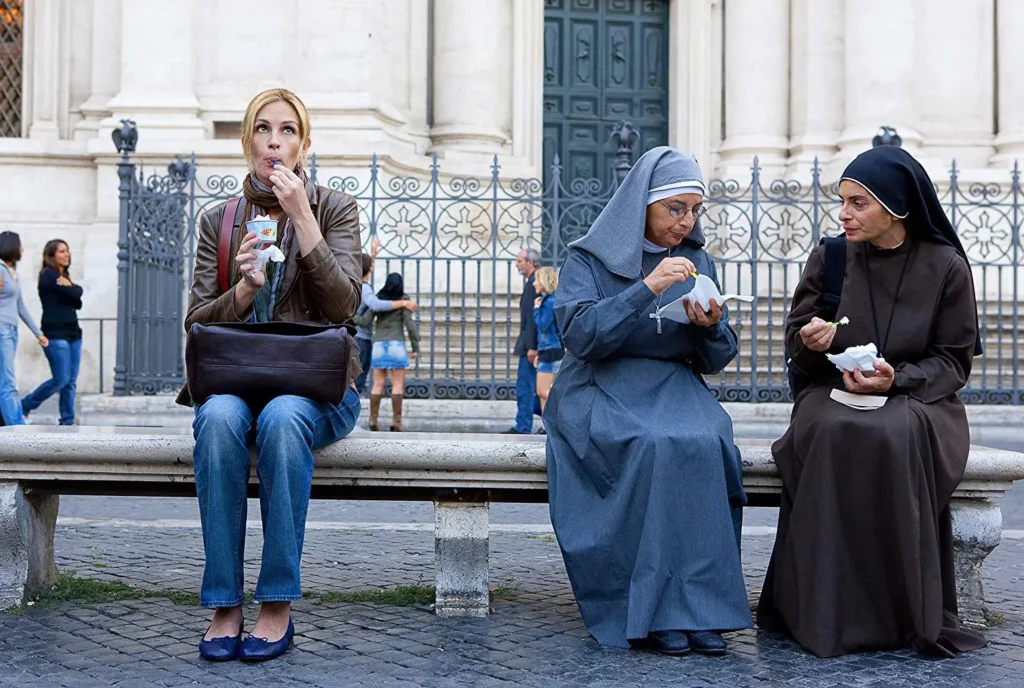
Todos esses locais são facilmente acessíveis a pé, de ônibus ou metrô saindo do YellowSquare Rome, perto da estação Termini. Seja para seguir os passos de uma estrela de cinema ou começar sua própria aventura solo, no Yellow você vai criar memórias dignas de um roteiro de cinema.
Fontes:
https://www.turismoroma.it/it/pagina/la-dolce-vita
https://www.wantedinrome.com/news/italy-rome-tourists-fined-bathing-trevi-fountain.html
https://almostginger.com/the-talented-mr-ripley-filming-locations/
https://www.cntraveler.com/story/where-was-gladiator-ii-filmed
https://www.cineguides.com/the-lizzie-mcguire-movie-2003-filming-locations
https://almostginger.com/eat-pray-love-filming-locations-rome/
https://www.rome.net/piazza-di-spagna
Leia mais
Travel
Por que escolhi viajar em albergues
Viajar é uma das experiências que mais enriquece a vida do ser humano. Hoje em dia, há uma tendência crescente entre os jovens de fazer viagens frequentes ao exterior, sozinhos ou acompanhados.
Mas com qual espírito de viajar?
Há quem prefira o conforto de um hotel de luxo ou de um apartamento privado, acomodações que certamente oferecem comodidades e facilidades que tornam as férias mais agradáveis.
Há quem se lance em aventuras ousadas a bordo de um camper ou com uma barraca e mochila.
No meu caso, acredito que ficar em albergues seja o meio termo perfeito, o compromisso que une a segurança de um teto sobre a cabeça com a sensação de desconhecido e novidade que busco em uma viagem.
O encanto dos albergues
Os albergues, com seus preços acessíveis, permitem viajar muito mais vezes e visitar mais lugares. Até hoje, esse método me permitiu visitar cerca de quinze países estrangeiros, incluindo França, Alemanha, Luxemburgo, Bélgica, Inglaterra, Marrocos, Croácia, Eslovênia, Jordânia, Espanha, Suíça, Portugal e outros.
Cada viagem é uma experiência inesquecível que carrego dentro de mim, junto com tudo o que aprendi.
O que mais gosto nos albergues é a oportunidade de conhecer e interagir com pessoas de todas as idades, origens e culturas. É como um portal aberto para outra dimensão da realidade, à qual pode acessar qualquer um que tenha dentro de si um espírito sonhador e aventureiro, faminto por experiências e pela vida.
Minha viagem à Jordânia
Lembro-me da minha viagem à Jordânia, há alguns anos. Eu tinha 21 anos e nunca tinha saído da Europa. Eu estava passando por uma fase de tédio e frustração, ansiava por algo diferente, uma fuga da vida cotidiana; então decidi escapar da minha realidade e embarcar nessa jornada solo.
Então, com a mochila nas costas, um voo de 30 euros ida e volta e poucos euros sobrando para albergues e para visitar a cidade, aterrissei em Amã, a capital.Ali, no primeiro albergue onde fiquei, conheci um jovem casal. Com eles, visitei o famoso anfiteatro romano, uma imponente testemunha da história milenar da Jordânia. Eu nunca imaginaria descobrir tanta beleza no coração de uma cidade tão caótica.
Durante minha estadia no albergue, também tive a sorte de conhecer alguns locais. Conversando com eles, descobri os segredos para me locomover pelo país gastando pouco. Eles me contaram sobre os ônibus locais, rotas menos conhecidas pelos turistas e como encontrar as melhores acomodações econômicas.
Graças aos conselhos deles, no dia seguinte peguei a mochila e fui em direção a Petra, a lendária cidade esculpida na rocha pelos nabateus, uma das 7 maravilhas do mundo.
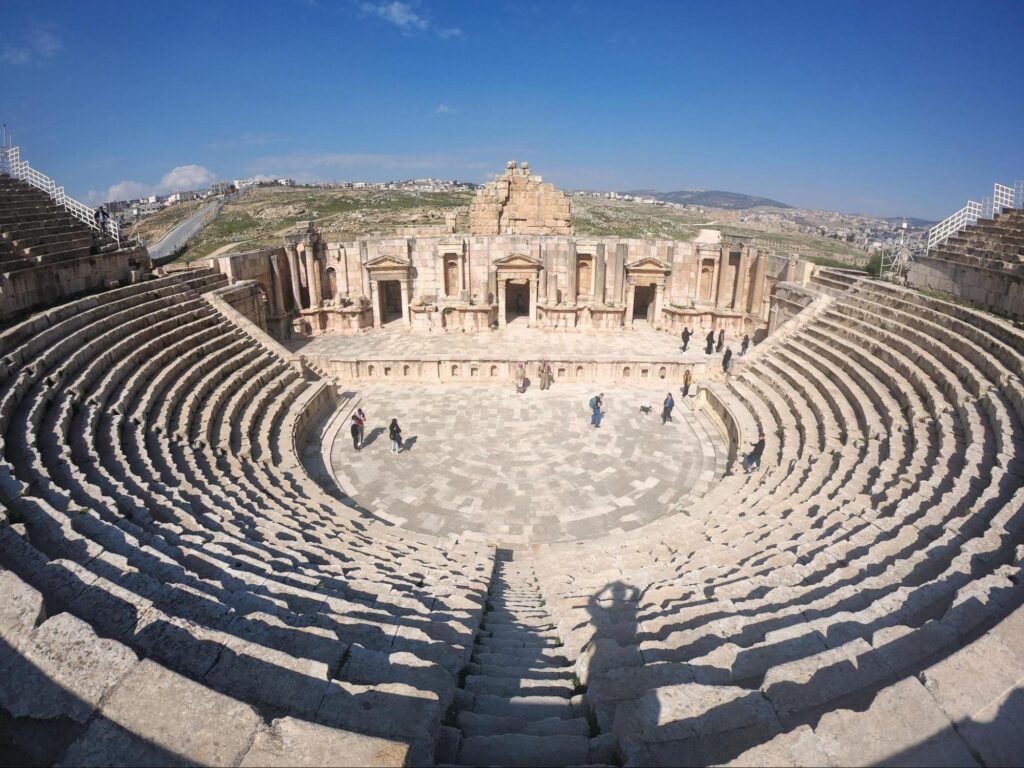
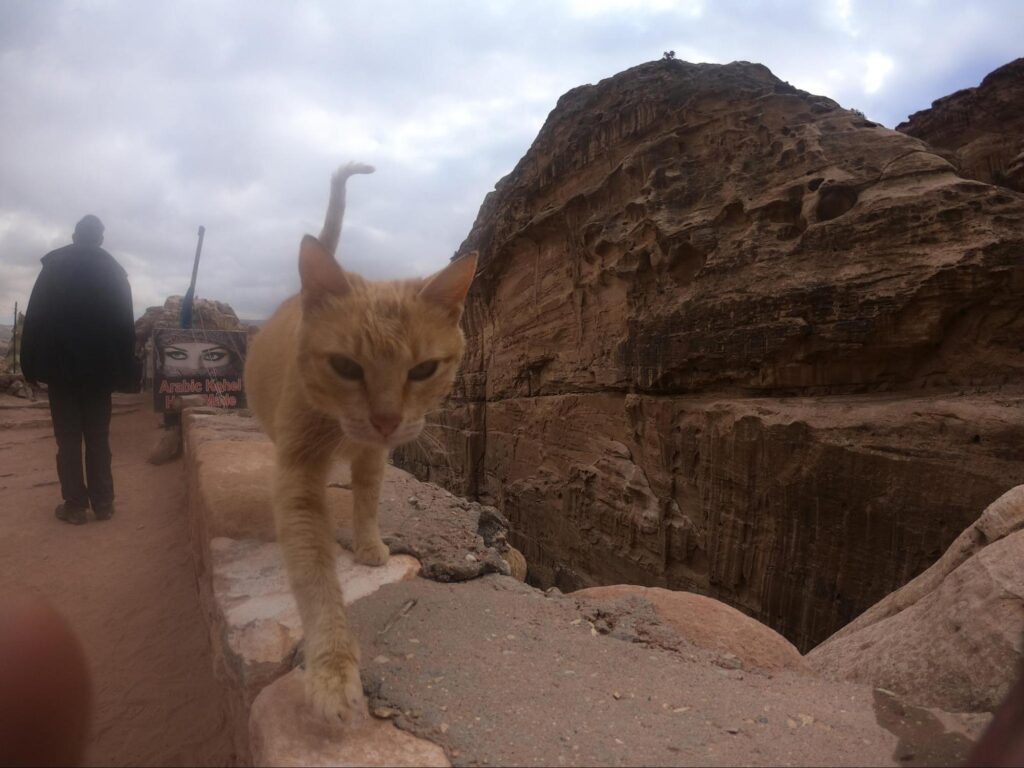
A chegada a Petra
Chegar lá foi uma viagem em si: horas em um ônibus capenga, paisagens desérticas passando pela janela e a sensação de estar cada vez mais distante de tudo o que conhecia.
Quando finalmente cheguei, encontrei um albergue que parecia saído de um conto de fadas do deserto: simples, mas acolhedor, com camas beliche que rangiam e uma varanda onde se podia admirar o céu estrelado (tudo isso por incríveis 8 euros).
Petra me deixou sem palavras. Caminhar entre aquelas rochas esculpidas séculos atrás foi uma experiência que nunca esquecerei. Passei horas explorando o local, imaginando a vida que ali se passava, trocando sorrisos e palavras com outros viajantes e beduínos que encontrei ao longo do caminho.

Conclusão: mais do que uma viagem
Os albergues foram o fio condutor de toda a minha viagem à Jordânia. Lugares onde não apenas encontrei uma cama econômica, mas também uma comunidade, um refúgio e histórias para ouvir.
Todas essas experiências me fizeram entender que viajar não é apenas conhecer lugares novos, mas também se abrir para as pessoas e culturas que os habitam.
Até hoje, quando penso naquela viagem, sinto uma doce nostalgia e um senso de gratidão. O que começou como uma forma de escapar da minha realidade cotidiana se transformou em uma das experiências mais formativas da minha vida.
Leia mais
Italy, Milan
Bate-voltas a partir de Milão: 1 dia de viagem
Você sabia que há muitos lugares incríveis para ver e visitar a poucos minutos de Milão?
Estou compartilhando minha experiência como viajante solo no Lago de Como, junto com outras ideias de bate-voltas que estão na minha lista e que já pesquisei.
Bora lá? Meu bate-volta partindo de Milão:
Antes de começar a viagem, fiz uma caminhada matinal e tomei um café com uma amiga. Às 8h, saí de Porta Romana e fui caminhando até o Castello Sforzesco. Eu amo andar de manhã, e como era julho, o sol já estava forte, mas ainda agradável — perfeito para um dia fora da cidade.
Atrás do Castello Sforzesco, paramos para tomar um café. Era minha primeira vez naquela região, e achei super viva, com clima universitário, cafés fofos e gente correndo ou fazendo exercício logo cedo.
Pastelaria Martesana
É mais uma confeitaria do que um café, mas perfeita para um doce com um ótimo espresso.
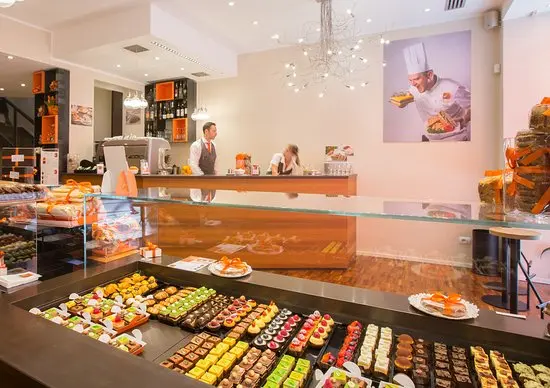
Depois do café, me despedi da minha amiga e parti para o bate-volta solo. Chegar até Como foi super fácil — e agora te conto como foi meu dia:
1. Como
Por que visitar?
Um lugar incrível a menos de uma hora de Milão. Como é uma mistura de lago e montanha — com feirinhas de Natal no inverno, vistas de tirar o fôlego no outono e muitas atividades ao ar livre no verão: passeios de barco, esportes aquáticos ou só relaxar ao sol. Sem falar na comida boa!
O que ver?
Beira do Lago de Como — perfeito para caminhar

Basílica de San Fedele

Duomo de Como — um espetáculo gótico

Funicular para Brunate — com vista incrível (6€ ida e volta)
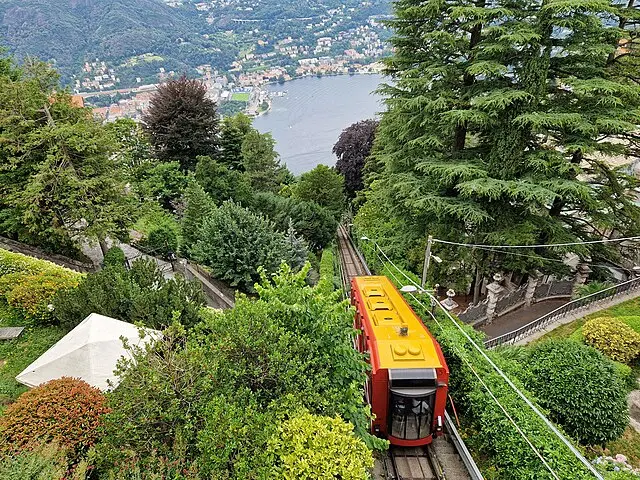
Mas eu decidi fazer trilha! Caminhar é uma das minhas paixões, e acho a melhor forma de conhecer um lugar novo.

É fácil encontrar a entrada da trilha mesmo sem Google Maps. Tem placas saindo do Duomo que levam até lá. A trilha é leve, mas é toda em subida. Depois de andar pela cidade e pelo lago, pode cansar um pouco — mas vale totalmente a pena.
Duração: 1h30
Distância: 3km (ou 6km se voltar caminhando)
No caminho, vi uma família de javalis — foi a primeira vez que vi ao vivo! Eu estava sozinha e fiquei um pouco nervosa, porque dizem que as mães podem ser protetoras. Mas no fim, se você não faz nada, elas também não fazem nada.
Chegando lá em cima, eu estava com muita fome, então parei no primeiro lugar que vi e pedi um pratão de massa. Só depois disso é que curti a vista merecida do farol. O verdadeiro prêmio não era só a comida, mas o momento de respirar e contemplar o lugar que cheguei.


Curiosidades
George Clooney tem uma villa no Lago de Como.
A cidade é famosa pela produção de seda de altíssima qualidade.
Como chegar desde Porta Romana
– Bonde: Bonde 9 da Viale Tunisia até Milano Centrale (10 min – €2,20)
– Trem: Milano Centrale → Como San Giovanni (40 min – €5–8 ida)
– A pé: Da estação ao centro da cidade (10 min)
– Tempo total: ~1 hora (ida, mas saí às 10h e voltei às 20h)
– Custo total (ida e volta): €15–20
Como disse antes, tem muitos destinos próximos de Milão que valem o bate-volta. Na próxima vez que estiver por lá, reserve um dia!
2. Pavia – Cultura, história e boa comida
Por que visitar?
Pavia é uma cidade universitária com um clima tranquilo e um centro histórico cheio de monumentos medievais e renascentistas. Perfeita para um bate-volta cultural e sem estresse.
O que ver?
- Ponte Coperto, o símbolo da cidade
- Duomo de Pavia, com uma das maiores cúpulas da Itália
- Castello Visconteo, onde ficam os Museus Cívicos
- Certosa di Pavia, um dos mosteiros mais lindos da Itália (entrada gratuita)
Curiosidades
O filósofo René Descartes estudou em Pavia.
A cidade abriga uma das universidades mais antigas da Europa (fundada em 1361).
Como chegar desde Porta Romana
Metrô: Linha M3 (amarela) de Repubblica até Milano Rogoredo (5 min – €2,20)
Trem: Milano Rogoredo → Pavia (30 min – €5–7)
A pé: Da estação ao centro histórico (10 min)
Tempo total: ~50 min
Custo total ida/volta: €14–18
3. Lago d’Iseo e Monte Isola – Natureza
Por que visitar?
Menos turístico que Como ou Garda, o Lago d’Iseo tem paisagens maravilhosas. A Monte Isola é a maior ilha habitada em lago da Europa — perfeita para quem curte caminhar e comer bem.
O que ver?
- Monte Isola — sem carros, ótima para bike ou trilha
- Santuário Madonna della Ceriola — vistas incríveis
- Beira do lago em Iseo — ideal para um aperitivo no pôr do sol
Curiosidades
Em 2016, o artista Christo criou “The Floating Piers”, uma passarela flutuante no lago.
Monte Isola é famosa pela “Soppressata”, seu embutido típico.
Como chegar desde Porta Romana
Metrô: Linha M3 (amarela) de Repubblica até Milano Centrale (2 min – €2,20)
Trem: Milano Centrale → Brescia (50 min – €7–10)
Trem local: Brescia → Sulzano (30 min – €3)
Balsa: Sulzano → Monte Isola (5 min – €5 ida e volta)
Tempo total: ~2 horas
Custo total ida/volta: €25–30
4. Vigevano – História e charme renascentista
Por que visitar?
A apenas alguns minutos de Milão, Vigevano é uma cidade charmosa com uma das praças mais bonitas da Itália. Ótima para um bate-volta cultural e relaxado.
O que ver?
- Piazza Ducale, projetada por Bramante
- Castello Sforzesco de Vigevano
- Museu do Calçado — para quem ama moda
Curiosidades
Leonardo da Vinci trabalhou em projetos arquitetônicos da cidade.
Vigevano é considerada a capital do calçado de luxo.
Como chegar desde Porta Romana
Bonde: Linha 9 da Viale Tunisia até Milano Porta Genova (15 min – €2,20)
Trem: Milano Porta Genova → Vigevano (35 min – €5)
Tempo total: ~1 hora
Custo total ida/volta: €14–15
Todas essas opções são super acessíveis de trem e com um orçamento amigável — abaixo de €60 o dia.
Aproveite a viagem! =)
Leia mais
Rome
Explore a cena LGBTQ+ em Roma!
Roma não é apenas uma das cidades mais bonitas do mundo, também é uma das mais animadas para a comunidade LGBTQ+. Com uma cena rica, a capital oferece locais acolhedores, noites inesquecíveis e uma atmosfera inclusiva. Seja você um local ou um visitante, este guia irá ajudá-lo a descobrir a melhor vida noturna e os locais gay-friendly da cidade.
As duas áreas mais icônicas para a comunidade LGBTQ+ são a Gay Street (perto do Coliseu) e o bairro Pigneto. A Gay Street é perfeita para um aperitivo relaxante, enquanto Pigneto, com sua vibe artística e alternativa, é ideal para quem busca uma atmosfera mais criativa e refinada.
Mas a cena LGBTQ+ de Roma não para por aí! Com uma incrível diversidade, a cidade oferece uma ampla gama de experiências: bares, baladas e até centros culturais para todos os gostos e estados de espírito.
Aqui estão alguns locais imperdíveis para aproveitar o melhor da vida noturna LGBTQ+ de Roma.
Bares e Locais LGBTQ+
Coming Out
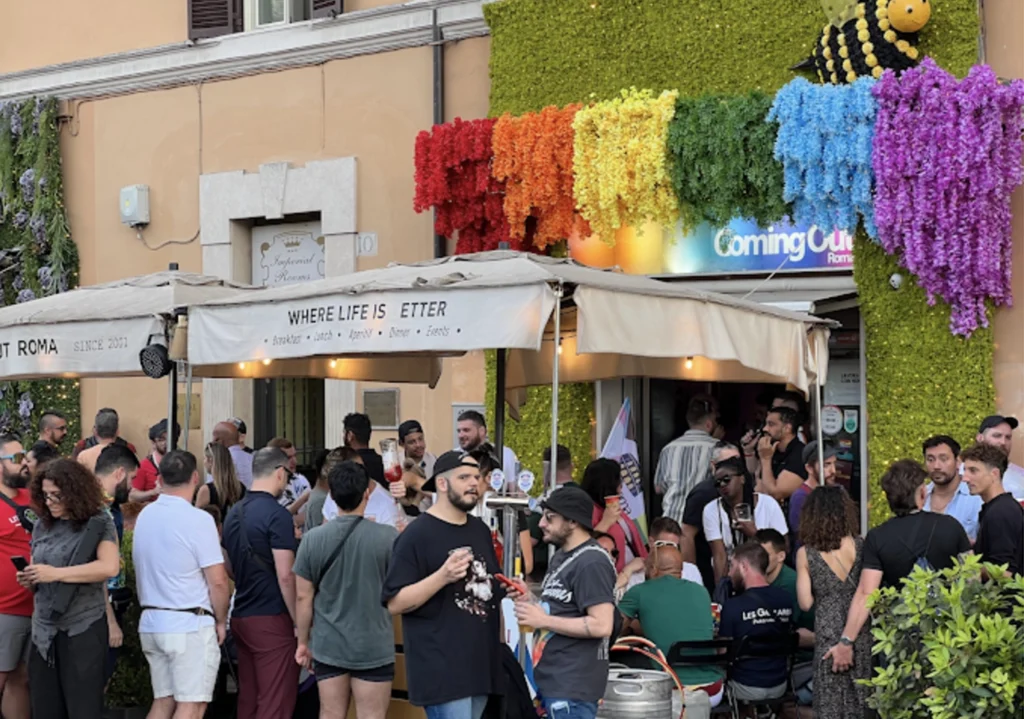
Este bar desempenhou um papel fundamental na transformação da Via S. Giovanni in Laterano na Gay Street de Roma. O que começou como um pequeno bar perto do Coliseu agora se tornou um ponto central para a comunidade LGBTQ+ da cidade. O Coming Out é o local perfeito para conhecer novas pessoas ou simplesmente curtir a atmosfera única da Gay Street.
Location: Coming out
101 Roma Club

Localizado entre Termini e o Coliseu, este local de vida noturna é perfeito para quem procura um ambiente relaxante e inclusivo. Você pode socializar na área principal do bar ou aproveitar mais privacidade no lounge íntimo. Seu lema diz tudo: “Seja livre para ser você mesmo.” Se você procura uma vibe descontraída e sem julgamentos, este é o lugar certo.
Location: 101 Roma Club
Malo Glitter Bar
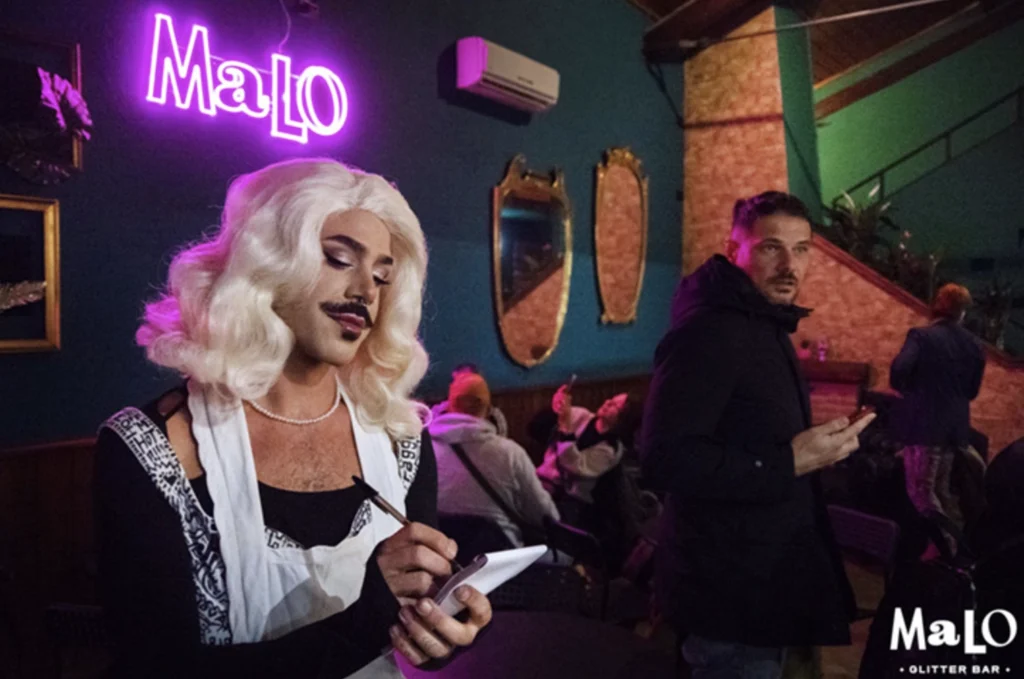
No coração de Pigneto, o Malo Glitter Bar é uma mistura perfeita de cultura e diversão. Além de servir coquetéis únicos e de alta qualidade, o local abriga exposições de arte, apresentações de drag queens, lançamentos de livros e palestras instigantes. É um espaço criativo onde arte e inclusão se encontram, tornando-o um destino de destaque para a comunidade LGBTQ+.
Location: Malo Glitter Bar
Onde dançar?
Roma é a cidade perfeita para quem ama dançar até tarde da noite. Com uma variedade de eventos LGBTQ+, há sempre algo acontecendo. Aqui estão algumas das festas mais icônicas.
GIAM
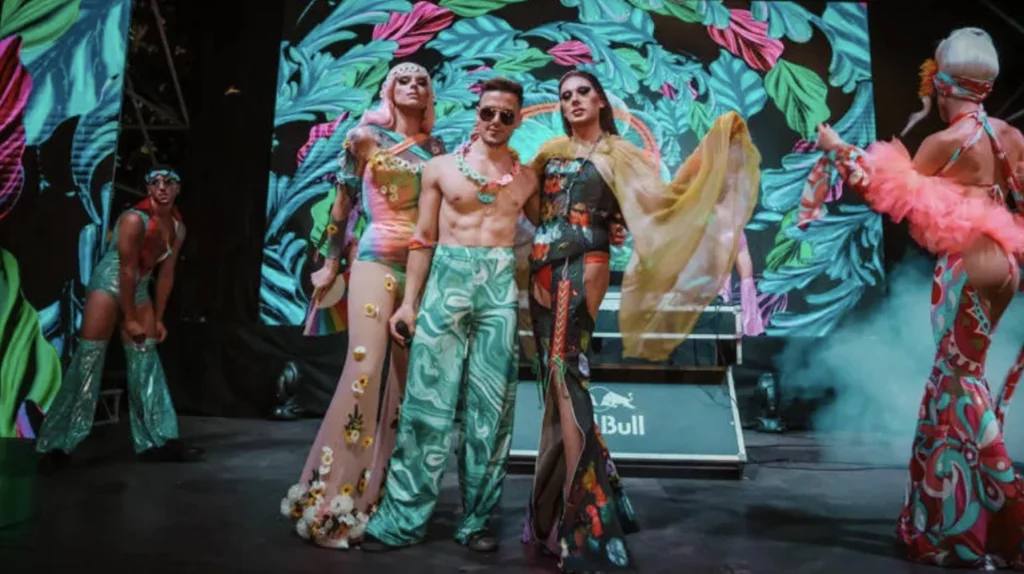
A festa de sábado à noite por excelência é o GIAM! Realizado no Planet Club, no bairro EUR (aqui está o endereço), este evento conta com DJs internacionais, performers extraordinários e uma energia elétrica que ilumina as noites de Roma durante todo o ano. Se você ama música eletrônica e uma vibe de alta energia, esta é a festa para você.
Location: GIAM
POPPE Party

Este evento queer-friendly celebra a cultura pop em todas as suas formas. A cada dois sábados, no Monk (aqui está o endereço), você pode dançar ao som de batidas de R&B, remixes nostálgicos e hits atuais, tudo curado pelos melhores DJs. É a noite ideal para os amantes da música pop e para quem busca uma mistura de nostalgia e estilo moderno.
Location: POPPE party
Latte Fresco
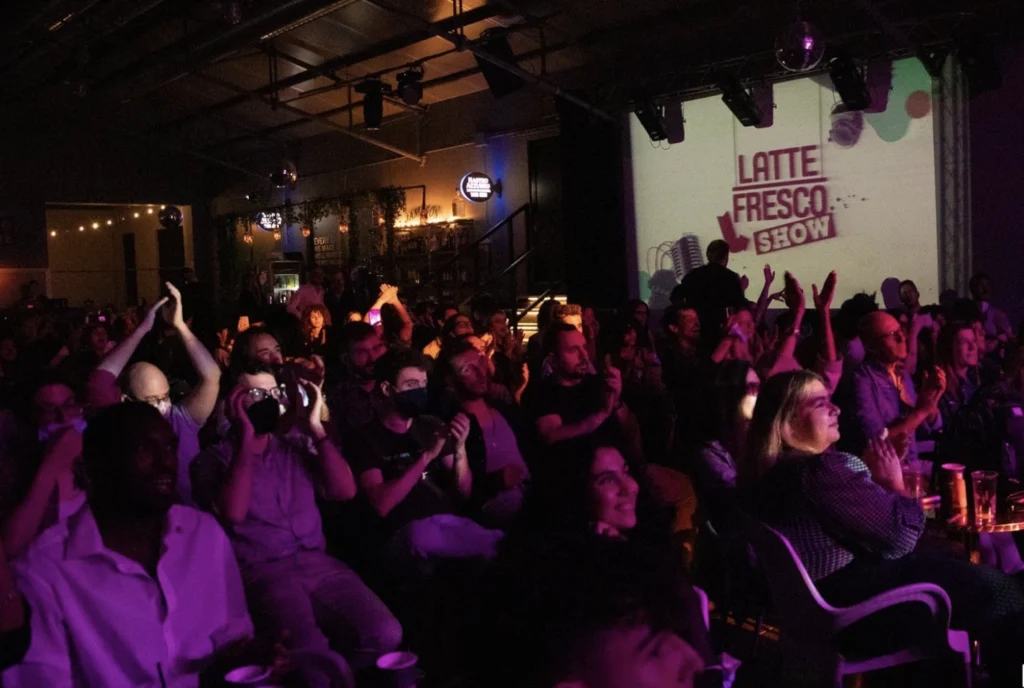
Uma das festas mais diversificadas de Roma acontece toda sexta-feira no Largo Venue (aqui está o endereço). Toda sexta-feira, você pode curtir um mix de stand-up comedy, karaokê e performances de drag queens antes da meia-noite – perfeito para tomar um drink com os amigos. Depois da meia-noite, até às 4h da manhã, a pista de dança ganha vida com uma ampla gama de músicas, acompanhada de concursos onde o público pode subir ao palco e dançar ao lado dos DJs e drag queens.
Location: Latte Fresco
Mais do que uma saída: Cultura e Comunidade
Se você está procurando algo além de bebidas e dança, Roma também oferece espaços como centros culturais LGBTQ+. Aqui você pode participar de eventos culturais e atividades focadas em ativismo, enriquecendo sua experiência dentro da comunidade.
Pronto para descobrir Roma?
Essas são apenas algumas sugestões para explorar a cena LGBTQ+ de Roma, mas há muito mais para descobrir! Saia, divirta-se e deixe-se surpreender por uma cidade que sabe como recebê-lo com calor e cor. 🌈✨
Com amor, Chiara
Leia mais
Roma
Aventura Ron-romana: Um guia aos gatos de Roma
Roma, uma cidade rica em história e cultura, tem uma conexão profunda com os seus habitantes felinos. Há séculos que os gatos fazem parte integrante da vida romana, estando a sua presença entrelaçada no tecido da história e da cultura da cidade. Quer saber onde os pode encontrar? Leia!
Binó-miau histórico perfeito
A relação entre os romanos e os gatos remonta aos tempos antigos. Os romanos eram conhecidos pela sua abordagem prática da criação de animais, e os gatos eram valorizados pela sua capacidade de controlar as populações de roedores. Este benefício prático cimentou o papel dos gatos na sociedade romana.

Mas, para além do seu papel prático, os gatos também têm um significado cultural em Roma.
Ao longo da história, muitos romanos famosos expressaram o seu amor pelos gatos. Um exemplo notável é o poeta Catulo, que escreveu vários poemas sobre o seu gato de companhia, Bituitus.
Particularmente na Idade do Império, os felinos eram considerados sagrados pelos romanos, influenciados pelo culto de Ísis, uma deusa egípcia que era muito adorada em Roma nessa época. Ísis era muitas vezes representada com um gato ou uma cria de gato sagrada, simbolizando as suas qualidades protectoras e maternais.
Gattare de Roma: uma história de amor milenar
O culto de Ísis era particularmente popular entre as mulheres, que procuravam a sua ajuda em questões de amor, fertilidade e parto.
Esta conexão entre gatos e mulheres também se reflete na língua italiana: a palavra gattara é uma gíria romana que se refere a uma mulher que cuida de gatos vadios. Estas pessoas dedicadas desempenham um papel crucial na vida da população felina de Roma, fornecendo comida, abrigo e cuidados médicos aos gatos necessitados.
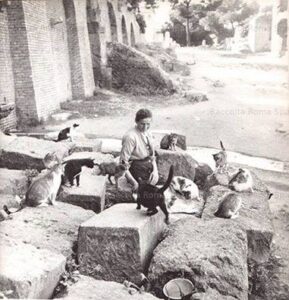
Os gatos na Roma moderna
Atualmente, os gatos continuam a prosperar em Roma. Podem ser encontrados a passear pelas praças históricas da cidade, a descansar nos parapeitos das janelas ensolaradas e a explorar as ruínas antigas. Muitos romanos têm um profundo afeto pelos gatos e tratam-nos como membros queridos das suas famílias.
Estes são alguns dos sítios onde os pode encontrar, ou mesmo apoiá-los com donativos, enquanto desfruta das belas paisagens da Cidade Eterna:
- Piramide Cestia: https://maps.app.goo.gl/p7zLBeKxkQdKdzXu5
O antigo sepulcro romano de Piramide Cestia é também um santuário para uma próspera colónia de gatos. Estes felinos fizeram da pirâmide a sua casa, acrescentando um toque de encanto ao sítio histórico. - Porta Magica: https://maps.app.goo.gl/xs7C6V7UHJrQcLJPA
Porta Magica, um arco misterioso situado no bairro de Prati, é também o lar de uma pequena mas simpática colónia de felinos. Podem ser vistos frequentemente a descansar nos degraus ou a explorar a área circundante. - Torre Argentina: https://maps.app.goo.gl/5YesZ5ZmA9iUXcwo6
A Torre Argentina, um sítio arqueológico histórico em Roma, é conhecida pela sua próspera colónia de felinos. Este grupo de gatos fez a sua casa nas ruínas de um antigo templo romano, criando uma visão única e enternecedora. - Cimitero Monumentale del Verano and Cimitero Acattolico: https://maps.app.goo.gl/ctSfTb9d1V6sqKsk8
Estes dois cemitérios em Roma, conhecidos pelo seu valor histórico e pela sua arquitetura notável, são também o lar de colónias de felinos. Os gatos encontraram refúgio entre os túmulos e monumentos, criando uma atmosfera única e pacífica.
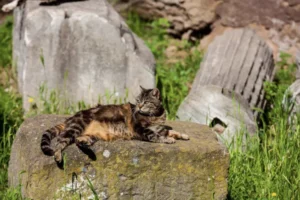
Bonus:
Bonus: CATS – um Miau-sical romano
O icónico musical CATS foi adaptado para o público italiano em 2023 com um toque romano único. Tendo como pano de fundo a Cidade Eterna, esta produção italiana capta a essência do original ao mesmo tempo que incorpora elementos da cultura e da história romanas.
Com as antigas ruínas romanas como tela de fundo, o cenário do musical proporciona um cenário cativante e autêntico para o baile anual dos Jellicle Cats.
Pode assistir a este espetáculo encantador, pelo segundo ano consecutivo, no Teatro Sistina, a partir de maio de 2025
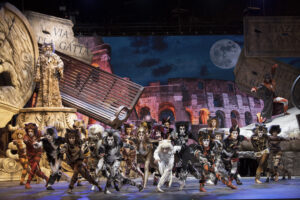
Aonde ir: https://maps.app.goo.gl/vmqf5HZtcmM52A5E6
A conexão entre romanos e gatos é um testemunho do amor e respeito duradouros que os humanos podem ter pelos animais. Os gatos têm desempenhado um papel vital na história e na cultura de Roma: à medida que a cidade continua a evoluir, a presença dos gatos continuará, sem dúvida, a ser uma parte preciosa da sua identidade.
